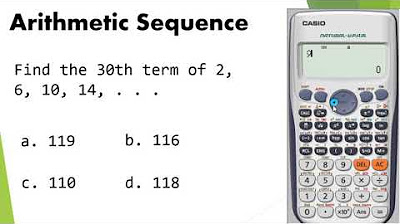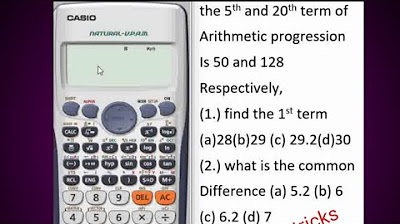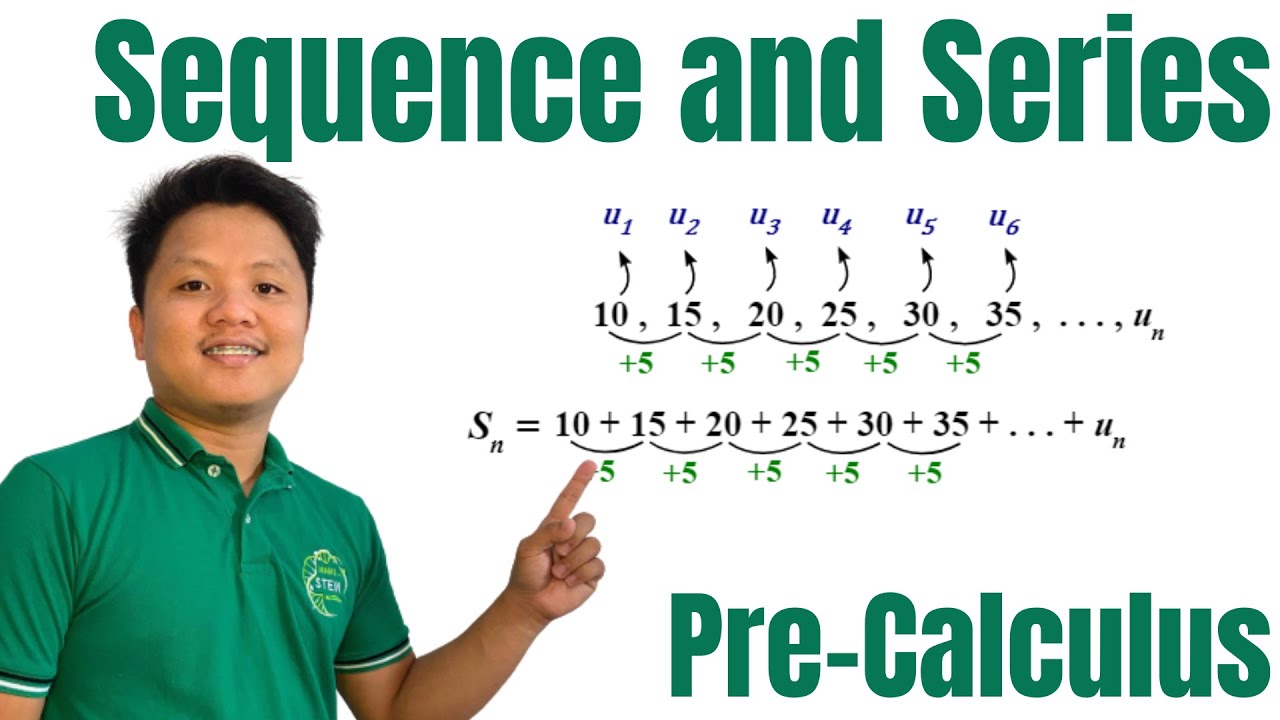Arithmetic Progression and Sequence Calculator Techniques | Engr. Yu Jei Abat | AbatAndChill
TLDRThis tutorial delves into arithmetic progressions and calculator techniques, guiding viewers through solving basic problems involving sequences with a common difference. It demonstrates how to find specific terms and the sum of terms in an arithmetic sequence using a calculator, without relying on formulas. The presenter provides step-by-step instructions for inputting values, using statistical and summation modes, and interpreting results, ensuring a clear understanding of the concepts and practical application.
Takeaways
- 📚 The video discusses calculator techniques for solving problems related to arithmetic progressions.
- 🔍 It provides a step-by-step guide on how to find the 30th term of an arithmetic sequence using a calculator.
- 📈 The common difference in an arithmetic sequence is consistently the same between consecutive terms, which is identified as 3 in the given example.
- 🔢 The method involves using the mode stat and a + b x functions on the calculator to input the first two terms of the sequence.
- 📉 To find a specific term, the video demonstrates using the shift and store functions, followed by the appropriate calculator commands to solve for the term.
- 📝 The video also explains how to determine which term in the sequence a given number belongs to, using the calculator's statistical functions.
- 🔑 For finding the common difference of an arithmetic progression, the video shows using the calculator's statistical mode to input the first and a specific term, then using the 'B' function.
- 📐 The script includes a problem-solving approach for sequences defined by a general term, such as finding the 20th term of a sequence given by 2^(n+5).
- 📊 The video demonstrates how to calculate the sum of the first 20 terms of a sequence using the calculator's summation function.
- 🎓 The tutorial is aimed at helping viewers understand and apply calculator techniques to arithmetic progression problems without memorizing formulas.
- 👨🏫 The presenter encourages viewers to subscribe and explore more tutorials on calculator techniques and other subjects on their YouTube channel.
Q & A
What is the main topic of the video?
-The main topic of the video is about arithmetic progression, specifically discussing calculator techniques for solving problems related to arithmetic sequences.
What is an arithmetic progression?
-An arithmetic progression is a sequence of numbers in which each term after the first is obtained by adding a constant difference to the preceding term.
How does the video demonstrate finding the 30th term of an arithmetic sequence?
-The video demonstrates finding the 30th term by using a calculator in mode stat, inputting the first two terms of the sequence, and then using the calculator's statistical functions to find the 30th term, which is 88.
What is the common difference in the given arithmetic sequence 1, 4, 7, 10, ...?
-The common difference in the given arithmetic sequence is 3, as each term is obtained by adding 3 to the previous term.
How can you determine which term of an arithmetic sequence a specific number belongs to?
-You can determine the term by using the calculator's statistical functions to input the first two terms of the sequence and then finding the term number that corresponds to the specific number, as demonstrated with the number 49 being the 17th term.
What is the method to find the common difference of an arithmetic progression without using a formula?
-The method involves using the calculator's statistical mode to input the first term and a known term of the sequence, then using the calculator's functions to find the common difference, as shown with the 10th term being 39 and the first term being 3.
How does the video solve for the 20th term of a sequence with the general term 2^(n + 5)?
-The video solves for the 20th term by using the calculator's table mode, inputting the general term as a function of x, and then calculating the value of the function at x = 20.
What is the sum of the first 20 terms of the sequence with the general term 2^(n + 5)?
-The sum of the first 20 terms of the sequence is calculated using the calculator's summation mode, and the result is 2,972.
What is the significance of using calculator techniques for arithmetic progression problems?
-Using calculator techniques can simplify the process of solving arithmetic progression problems, especially when dealing with large numbers or when the formula is not readily available or forgotten.
How can the video's content be applied to other mathematical problems?
-The techniques demonstrated in the video can be applied to other mathematical problems that involve sequences and series, such as finding terms or sums in geometric progressions or other types of sequences.
Outlines
📚 Arithmetic Progression Calculation Techniques
This paragraph introduces the topic of arithmetic progression and calculator techniques. The speaker explains the concept of an arithmetic sequence with a common difference between terms, using the sequence 1, 4, 7, 10 as an example. The main focus is on finding the 30th term of the sequence using a calculator. The process involves entering the first two terms into the calculator, storing the values, and then using the mode stat to find the 30th term, which is calculated to be 88.
🔍 Identifying the Term for a Given Number in an Arithmetic Sequence
The second paragraph discusses how to determine the term number for a given value within an arithmetic sequence. The example provided is finding out which term number 49 is in the sequence 1, 4, 7, 10, etc. The method involves using the calculator's mode stat and entering the first two terms of the sequence. After storing these values, the speaker demonstrates how to use the calculator to find that 49 is the 17th term of the sequence.
🔢 Finding the Common Difference in an Arithmetic Progression
In this paragraph, the speaker simplifies the process of finding the common difference of an arithmetic progression without using the formula. Given the first and tenth terms of a sequence, the speaker uses the calculator's mode stat and enters these terms to find the common difference, which is calculated to be 4. This method is useful for those who may have forgotten the formula or for quick calculations.
📈 Calculating Specific Terms in a Given Sequence
The focus of this paragraph is on finding specific terms in a sequence defined by a general term formula, 2^n + 5. The speaker explains how to use the calculator to find the 20th term of this sequence. The process involves setting up the calculator to input the general term, starting from the first term up to the 20th, and then observing the value for the 20th term, which is found to be 1,148,858.
📊 Summing the First 20 Terms of a Sequence
The final paragraph deals with the task of summing the first 20 terms of the sequence with the general term 2^n + 5. The speaker demonstrates how to use the calculator's summation function to perform this calculation. By entering the general term and specifying the range from the first term to the 20th, the calculator computes the sum to be 2,097,272. The speaker concludes by encouraging viewers to subscribe and explore more tutorials on the channel.
Mindmap
Keywords
💡Arithmetic Progression
💡Calculator Techniques
💡Common Difference
💡Sequence
💡Term
💡Mode Stat
💡Shift and Store
💡Y-hat (Ȳ)
💡X-hat (Ⱥ)
💡General Term
💡Summation
Highlights
Introduction to the topic of arithmetic progression and calculator techniques.
Explaining the concept of an arithmetic sequence, identifying the common difference between terms.
Demonstration of finding the 30th term in an arithmetic sequence using a calculator.
Using the mode, a+b×n formula to calculate terms in an arithmetic progression.
Entering the first two terms of the sequence into the calculator to find subsequent terms.
Clearing the calculator and storing data for further calculations.
Using the shift and stat functions to find the 30th term of the sequence.
Reversing the problem to identify which term in the sequence equals 49.
Storing initial terms and using the calculator to find the term number for a given value.
Finding the common difference of an arithmetic progression without using a formula.
Using the calculator to input terms and calculate the common difference.
Solving for the 20th term of a sequence with a given general term formula.
Entering the general term into the calculator to calculate specific terms of a sequence.
Calculating the sum of the first 20 terms of a sequence using the summation function on a calculator.
Using the computation mode to sum up terms in a sequence.
Final calculation of the sum of the first 20 terms, yielding a result of 2,097,2.
Encouragement for viewers to subscribe and engage with the channel for more tutorials.
Transcripts
Browse More Related Video

Caltech in solving nth term of Arithmetic Sequence using Casio fx - 570ES PLUS Calculator

Solving arithmetic progression with casio calculator @FUNAI_1010 (calculator tricks part 3)

Introduction to Series and Summation Notation (Precalculus - College Algebra 68)

Summation Formulas and Sigma Notation - Calculus

Decimal Degrees to DMS Formula - Converting Degrees Minutes and Seconds to Decimal - Trigonometry

Sequence and Series | Terms of Sequence and Associated Series | Pre-Calculus
5.0 / 5 (0 votes)
Thanks for rating: